International Journal of Computer Network and Information Security @ijcnis
Статьи журнала - International Journal of Computer Network and Information Security
Все статьи: 1166
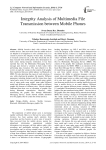
Integrity Analysis of Multimedia File Transmission between Mobile Phones
Статья научная
Mobile forensics deals with evidence from mobile devices. Data recovered from the mobile devices are helpful in investigation to solve criminal cases. It is crucial to preserve the integrity of these data. According to research carried out [1], it has been noted that not all data extracted from mobile phones have discrepancies in hash values during integrity verification. It has been reported that only the Multimedia Messaging Service message type showed a variation in hash values when performing data extraction. The main objective in this work is to study the variance in the content of the graphic files transferred between mobile phones via Bluetooth or MMS. We also determine the causes of such variations, if any, while checking the graphics file integrity. Different parameters including distance and file format have been varied and a series of test were conducted using: mobile sets of same make same model, same make different model and different make different model on different graphic file formats of different sizes. Results obtained confirmed that there was no alteration of graphic files during Bluetooth transmission. However, while transmitting the graphic files through Multimedia Messaging Service, results showed notable alteration level for graphic files of certain file format and size.
Бесплатно
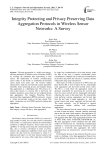
Статья научная
The data aggregation is a widely used energy-efficient mechanism in wireless sensor Networks (WSNs), by avoiding the redundant data transmitting to base station. The deployment of wireless communicating sensor nodes in the hostile or unattended environment causes attack more easily and the resource limited characteristics make the conventional security algorithms infeasible, hence protecting privacy and integrity during data aggregation is a challenging task. The privacy of a sensor data ensures, it is known only to itself and the integrity guarantees sensor data has not tampered during data aggregation. The Integrity Protecting Privacy preserving Data Aggregation (IPPDA) protocols ensures a robust and accurate results at the base station. This paper summarises on such IPPDA protocols during data aggregation.
Бесплатно
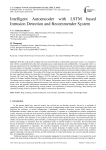
Intelligent Autoencoder with LSTM based Intrusion Detection and Recommender System
Статья научная
With the swift growth of digital networks and information in both public and private sectors, it is essential to deal with the considerable threat that network attacks pose to data integrity and confidentiality. Consequently, there is a pressing requirement for the establishment of effective mechanisms to detect and provide recommendations for addressing intrusion attacks. In this paper, we propose a semantic-based intrusion detection system that aims to improve performance by incorporating semantic representations consisting of feature groups and their associated weights, leading to the creation of a weighted knowledge graph. The weights of the features are determined using sparse autoencoders. From these weights, the most significant features are normalized to a specific range. This approach comprises a combination of a Deep Auto Encoder (AE) and Long Short-Term Memory (LSTM) networks for intrusion detection. Furthermore, the ensemble method of Extreme Gradient Boosting (XGBoost) is used to identify and recommend high-probability attack scenarios. The dataset used to evaluate is the CSE-CIC-IDS dataset. Performance metrics such as accuracy, precision, recall, false positive rate, receiver operating characteristic metrics, loss, and error rate are used to measure the performance, and the results show the approach demonstrates substantial improvements in detection accuracy, minimizing false positives, enhancing reliability, and outperforming existing models. The combination of semantic knowledge, deep learning, and ensemble learning ensures a proactive and adaptive cybersecurity framework.
Бесплатно
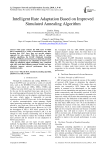
Intelligent Rate Adaptation Based on Improved Simulated Annealing Algorithm
Статья научная
This paper analyzes the PHY layer of IEEE 802.11 standards for a variety of transmission rates, after learning that MAC layer does not provide adaptive approach for rate control. With the study of various adaptive algorithms, the SAARF (Simulated Annealing Auto Rate Fallback) protocol based on simulated annealing algorithm is proposed on rate adaptation in MAC Layer, which can adaptively adjust transmitting rate. Compared with ARF (Auto Rate Fallback) protocol, SAARF can more effectively improve network performance from the simulation results.
Бесплатно
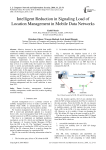
Intelligent Reduction in Signaling Load of Location Management in Mobile Data Networks
Статья научная
Massive increase in the mobile data traffic volume has recently resulted in a big interest towards the distributed mobility management solutions that aim to address the limitations and drawbacks of centralized mobility management. Location management is an important requirement in a distributed mobility management environment. To provide seamless Internet data services to a mobile node, the location of a mobile node is stored and periodically updated on a location server through a location update message that is sent by the mobile node. In this paper, we propose an intelligent approach of setting the period of sending location update messages on the basis of a mobile node's patterns of data sessions and IP handovers. We use a machine learning approach on the location server. The results show that our approach significantly reduces the signaling load of the location management and the overall reduction is more than 50%.
Бесплатно
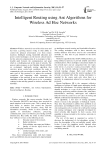
Intelligent Routing using Ant Algorithms for Wireless Ad Hoc Networks
Статья научная
Wireless network is one of the niche areas and has been a growing interest owing to their ability to control the physical environment even from remote locations. Intelligent routing, bandwidth allocation and power control techniques are the known critical factors for this network communication. It is customary to find a feasible path between the communication end point which is a challenging task in this type of network. The present study proposes an Ant Mobility Model (AMM), an on-demand, multi-path routing algorithm that exercises power control and coordinate the nodes to communicate with one another in wireless network. The main goal of this protocol is to reduce the overhead, congestion, and stagnation, while increasing the throughput of the network. It can be realized from the simulation results that AMM proves to be a promising solution for the mobility pattern in wireless networks like MANETs.
Бесплатно
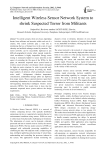
Intelligent Wireless Sensor Network System to shrink Suspected Terror from Militants
Статья научная
In current scenario, there are always impending threats from militants and terrorists within and out of a country. The sensor networks play a vital role in minimizing the loss of human lives in the event of usual calamity and artificial sabotage created by terrorists. The sensor networks can be successfully deployed in any difficult geographical terrains where manual round-the-clock surveillance is highly impossible. Energy aware routing is immensely helpful to sensor networks in the aspect of extending the life span of the WSNs. In this paper, an automatic suspected terror system based on wireless sensor networks is developed, which is designed for high-rise metro structure. In order to provide early extinguish of impending threats by putting any bomb, large numbers of detectors which periodically measure noise, smell, infringement, vibration, temperature concentration, unidentified stranger photo are deployed from major streets. Those scattered detectors report their monitoring information to the surveillance center via the self-organizing hierarchical intelligent wireless sensor networks (IWSN). Test results from it show that the automatic suspected terror system achieves the design requirements.
Бесплатно
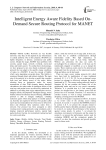
Intelligent energy aware fidelity based on-demand secure routing protocol for MANET
Статья научная
Mobile Ad-Hoc Networks are very flexible networks, since they do not depend on any infrastructure or central authority. Due to this property, MANETs are highly ubiquitous in defense, commercial and public sectors. Despite the usage, MANET faces problems with security, packet drops, network overhead, end-to-end delay and battery power. To combat these shortcomings, we have proposed a new trust based on-demand routing protocol that can adapt to the specific energy conditions of nodes in a MANET. It uses the concept of fidelity which varies depending on packet drops. This fidelity is monitored through direct and indirect methods. The main aim of the protocol is to develop a model that considers both trust and battery power of the nodes, before selecting them as prospective nodes for secure transmission of data. With dynamic battery threshold calculations, the nodes make an intelligent choice of the next hop, and packet losses are effectively minimized. In addition to providing data origin authentication services, integrity checks, the proposed “Intelligent Energy Aware Fidelity Based On-Demand Secure Routing (IEFBOD)” protocol is able to mitigate intelligent, colluding malicious agents which drop packets or modify packets etc. that they are required to forward. New packets called report and recommendation have been used to effectively detect and eliminate these malicious nodes from a network. Our protocol has been compared to other existing secure routing protocols using simulation, and it displays improved performance metrics, namely high packet delivery fraction, low normalized routing load and low end-to-end delay.
Бесплатно

Inter integrated WSN for crude oil pipeline monitoring
Статья научная
An inter-integrated system for crude oil pipeline using Wireless Sensor Network is designed for an incessant monitoring and communication in the desert for a span of 1350 Km from pumping station to harbor stockpiling tanks with 135 distributed control system stations. The proposed wireless sensor network equipment is used to scan the sensor status installed in the pipeline and send the required information utilizing dedicated low bandwidth with Quality of Service level three secured Message Queuing Telemetry Transport. This system generates energy on its own by using the solar panel and stores it in battery banks. Low power controller with Wi-Fi developed by Texas Instruments has been utilized to design a working prototype.
Бесплатно
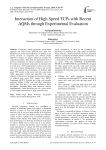
Interaction of High Speed TCPs with Recent AQMs through Experimental Evaluation
Статья научная
Congestion control approaches, source based approach and router based approach have their own limitations. In source based approach, it is difficult to get correct location of congestion and without proper admission control; we cannot effectively manage the congestion problem. Thus both the approaches have to work in coordination for effective congestion control. In this context, an interaction study plays an important role to verify how a TCP implemented at source end works with Active Queue Management at router end. In this paper, we analyzed the performance of different high speed TCP variants at the source end with some recent AQM approaches: CoDel and sfqCoDel. The main objective of this work is to obtain the interaction patterns of different high speed TCP variants like: HTCP, Compound, HSTCP, Scalable and Cubic with recently proposed AQMs: CoDel and sfqCoDel. Simulation results show that that if we want to achieve a better throughput, minimum delay and improved fairness simultaneously, Cubic-sfqCoDel may be a good choice of TCP-AQM combinations for high speed networks.
Бесплатно
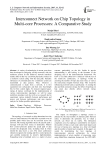
Interconnect network on chip topology in multi-core processors: a comparative study
Статья научная
A variety of technologies in recent years have been developed in designing on-chip networks with the multicore system. In this endeavor, network interfaces mainly differ in the way a network physically connects to a multicore system along with the data path. Semantic substances of communication for a multicore system are transmitted as data packets. Thus, whenever a communication is made from a network, it is first segmented into sub-packets and then into fixed-length bits for flow control digits. To measure required space, energy & latency overheads for the implementation of various interconnection topologies we will be using multi2sim simulator tool that will act as research bed to experiment various tradeoffs between performance and power, and between performance and area requires analysis for further possible optimizations.
Бесплатно
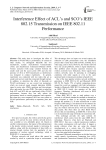
Interference effect of ACL’s and SCO’s IEEE 802.15 transmission on IEEE 802.11 performance
Статья научная
This study aims to investigate the effect of Bluetooth on WLAN 802.11 performance. In contrast to other studies, we distinguish bluetooth into two mechanisms, namely Asynchronous Connectionless (ACL) and Synchronous Connection-Oriented (SCO). Various scenarios (with range variation between the sender node and the access point (AP) and also the presence of ACL or SCO transmission as interference) was designed to conduct experiment. In general, experiment was conducted with two nodes that act as sender and receiver node that connected through internet. In addition, to determine the effect of bluetooth on WLAN performance we use several test parameters, which are received signal strength indication (RSSI), signal to noise ratio (SNR), upstream and downstream, jitter, and packet loss rate (PLR). The study revealed the both ACL and SCO did not significantly affect WLAN performance, because they can only reduce the performance based on certain parameters and scenarios. But when they were compared, SCO has worst effect on WLAN performance, particularly on upstream, jitter, and PLR.
Бесплатно
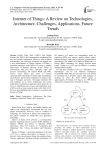
Internet of Things: A Review on Technologies, Architecture, Challenges, Applications, Future Trends
Статья научная
World Wide Web (1990's) and Mobile Internet (the 2000's) had consequential corroborated the way how people communicate. However, with evolution in technology, the cataclysm of Internet has stepped into a new phase-Internet of Things. Internet of Things, a prominent paradigm in the field of IT having a nominal intervention of humans allowing diverse things to communicate with each other, anticipate, sight, and perceive surroundings. IoT exploits RFID tags, NFC, sensors, smart bands, and wired or wireless communication technologies to build smart surroundings, smart Homes, quick-witted intelligence in medical care, ease of Transport, and more. This paper introduces IoT with emphasis on its driver technologies and system architecture. In addition to application layer protocols, we focus on identifying various issues and application areas of IoT as well as future research trends in the field of IoT. We have also highlighted how big data is associated with Internet of Things.
Бесплатно

Статья научная
The Internet is a communication network where two or more than two users communicate and exchange the data. Black hole attack is a security threat in which a malicious node drops some or all of the packets. The proposed framework implements a biometric authentication system into the communication network to verify the user and to save the user from any internal or external threat. The main objective is to integrate the biometric security with the communication network. The attack is supposed to be a Black hole which has been considered as a smart attack. Feature extraction of Fingerprint dataset will be done using minutiae extractor. This will extract ridge endings and ridge bifurcation from the thinned image. Genetic algorithm is usedto reduce the features to useful pool. If the user is authentic only then prevention mechanism against black hole is applied. Genetic Algorithm is used to find out black hole node based on the fitness function. Proposed model’s performance is evaluated using various metrics like delay, throughput, energy consumption and packet delivery ratio.
Бесплатно
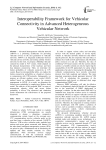
Interoperability Framework for Vehicular Connectivity in Advanced Heterogeneous Vehicular Network
Статья научная
Advanced heterogeneous vehicular network (AHVN) is a promising architecture for providing vehicular services in the next generation of vehicular networks. AHVN is an integrated architecture between vehicular ad hoc networks and existing cellular wireless networks. In this work, we propose a Multihop vehicular connectivity model in V2V system, which depends on the physical characteristics of the roadways and false hop initiation connectivity. Then, we determine the failure probability of vehicular connectivity in V2V system. Based on interoperability utility, we employ the failure connectivity probability as a handover criterion to communicate with V2R networks. Subsequently, we propose an efficient medium access control (MAC) method based on collaborative codes for resource management in AHVN. As a result, we determine the failure access probability by employing a Markov chain model. The analysis of the proposed MAC in terms of transmission capacity, delay and access failure probability is driven. The numerical and simulation results demonstrate the effectiveness of the proposed framework.
Бесплатно
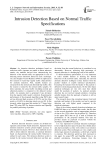
Intrusion Detection Based on Normal Traffic Specifications
Статья научная
As intrusion detection techniques based on malicious traffic signature are unable to detect unknown attacks, the methods derived from characterizing the behavior of the normal traffic are appropriate in case of detecting unseen intrusions. Based on such a technique, one class Support Vector Machine (SVM) is employed in this research to learn http regular traffic characteristics for anomaly detection. First, suitable features are extracted from the normal and abnormal http traffic; then the system is trained by the normal traffic samples. To detect anomaly, the actual traffic (including normal and abnormal packets) is compared to the deduced normal traffic. An anomaly alert is generated if any deviation from the regular traffic model is inferred. Examining the performance of the proposed algorithm using ISCX data set has delivered high accuracy of 89.25% and low false positive of 8.60% in detecting attacks on port 80. In this research, online step speed has reached to 77 times faster than CPU using GPU for feature extraction and OpenMp for parallel processing of packets.
Бесплатно
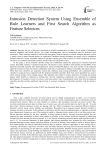
Статья научная
Recently, the use of Internet is increased for digital communication to share a lot of sensitive information between computers and mobile devices. For secure communication, data or information must be protected from adversaries. There are many methods of safeties like encryption, firewalls and access control. Intrusion detection system is mainly used to detect internal attacks in organization. Machine leaning techniques are mostly used to implement intrusion detection system. Ensemble method of machine learning gives high accuracy in which moderately accurate classifiers are combined. Ensemble classifier also provides less false positive rates. In this paper, a novel ensemble classifier using rule combination method has proposed for intrusion detection system. Ensemble classifier is designed using three rule learners as base classifiers. The benefits and feasibility of the proposed ensemble classifier have demonstrated by means of KDD’98 datasets. The main novelty of the proposed approach is based on three rule learner combination using rule of combination method of ensemble and feature selector. These three base classifiers are separately trained and combined using average probabilities rule combination. Base classifier’s accuracies have compared with the proposed ensemble classifier. Best First search algorithm has used to select relevant features from training dataset. This algorithm also helped to reduce dimension of training and testing dataset which benefits in reduction of training time. Several comparative experiments are conducted for evaluating performances of classifiers in term of accuracy and false positive rates. Experimental results show that the proposed ensemble classifier provide significant improvement of accuracy compared to individual classifiers with less positive rates.
Бесплатно
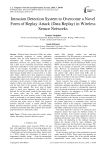
Статья научная
Wireless Sensor Networks (WSNs) are widely and successfully employed in various application domains. They are easily deployed to collect valuable information and monitor potential environmental phenomena. However, the special nature of WSNs as well as their severe constraints and resource limitations make them vulnerable to various types of threats. Replay attack, is one example. According to this attack, the adversary intercepts and replays several times the same (old) message leading either to missed alerts or to false alerts. Many solutions have been proposed to mitigate message replay attack. However, all these solutions are of cryptographic natures and consider only external attacks exercising a trivial scenario of replay attack. In fact, the attacker could be a lot smarter, and in this case, it replays only the data field in the message while keeping the remaining fields updated. This novel form of replay attack is much more dangerous and difficult to be detected. We call this attack variant by data replay attack. As sensor nodes may be easily captured and compromised, the worst scenario occurs if data replay attack is performed by an internal intruder. In this paper we propose an efficient intrusion detection framework to overcome data replay attack in WSNs. The proposed intrusion detection system is named DR-IDS (Data Replay Intrusion Detection System). The performance evaluations performed under NS2 simulator show that the proposed solution is sufficiently robust.
Бесплатно
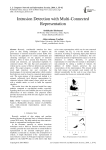
Intrusion Detection with Multi-Connected Representation
Статья научная
Recently, considerable attention has been given to data mining techniques to improve the performance of intrusion detection systems (IDS). This has led to the application of various classification and clustering techniques for the purpose of intrusion detection. Most of them assume that behaviors, both normal and intrusions, are represented implicitly by connected classes. We state that such assumption isn't evident and is a source of the low detection rate and false alarm. This paper proposes a suitable method able to reach high detection rate and overcomes the disadvantages of conventional approaches which consider that behaviors must be closed to connected representation only. The main strategy of the proposed method is to segment sufficiently each behavior representation by connected subsets called natural classes which are used, with a suitable metric, as tools to build the expected classifier. The results show that the proposed model has many qualities compared to conventional models; especially regarding those have used DARPA data set for testing the effectiveness of their methods. The proposed model provides decreased rates both for false negative rates and for false positives.
Бесплатно
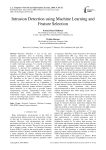
Intrusion detection using machine learning and feature selection
Статья научная
Intrusion Detection is one of the most common approaches used in detecting malicious activities in any network by analyzing its traffic. Machine Learning (ML) algorithms help to study the high dimensional network traffic and identify abnormal flow in traffic with high accuracy. It is crucial to integrate machine learning algorithms with dimensionality reduction to decrease the underlying complexity of processing of huge datasets and detect intrusions within real-time. This paper evaluates 10 most popular ML algorithms on NSL-KDD dataset. Thereafter, the ranking of these algorithms is done to identify best performing ML algorithm on the basis of their performance on several parameters such as specificity, sensitivity, accuracy etc. After analyzing the top 4 algorithms, it becomes evident that they consume a lot of time while model building. Therefore, feature selection is applied to detect intrusions in as little time as possible without compromising accuracy. Experimental results clearly demonstrate that which algorithm works best with/without feature selection/reduction technique in terms of achieving high accuracy while minimizing the time taken in building the model.
Бесплатно

